

Imagine stepping into a world where the past and present blend seamlessly, where the majestic silhouettes of ancient castles dot the lush landscapes of Cumbria. These castles, more than mere structures of stone and mortar, stand as enduring sentinels of history, each telling a unique story of ambition, power, and survival. Nestled in the picturesque regions of the Lake District and beyond, the castles of Cumbria invite visitors to embark on a journey back in time, to explore the rich tapestry of England’s medieval past.
The allure of these historical edifices goes beyond their architectural beauty and strategic locations. They are the keepers of centuries-old tales, from the Norman conquests to the turbulent times of the Border Reivers. Each castle, with its own distinctive features—from imposing fortresses designed for defense to elegant manors meant to display wealth and status—offers a glimpse into the lives of those who walked their halls.
As we delve into the world of Cumbria’s castles, we will uncover the historical events that shaped them, marvel at their architectural wonders, and discover the efforts to preserve these monumental legacies. Whether you’re a history enthusiast, an architecture aficionado, or simply seeking a journey through the scenic landscapes of Cumbria, these castles promise an unforgettable adventure.
In the pages that follow, we invite you to explore the major castles of the Lake District, each with its own story and splendor. From the ruins that whisper tales of bygone eras to the restored manors that continue to dazzle visitors, this guide will take you on an enchanting tour of Cumbria’s most treasured landmarks. Join us as we celebrate the history, beauty, and enduring legacy of Cumbria’s castles, a testament to the region’s rich heritage and the timeless allure of its landscapes.
Historical Background of Castles in the Region
The story of Cumbria’s castles is a narrative woven through the fabric of time, from the early medieval period to the present day. These fortresses, built primarily for defense, also served as symbols of authority and power, reflecting the turbulent history and strategic importance of the region.
The Early Motivations for Castle Construction
The origins of castle construction in Cumbria can be traced back to the aftermath of the Norman Conquest of England in 1066. The Normans, recognizing the strategic importance of controlling the border regions between England and Scotland, embarked on a campaign of castle building to secure their hold over the area. These early castles were primarily motte-and-bailey structures—earthen mounds with wooden or stone keep atop and a fenced courtyard below. They were quick to construct and served as effective fortresses against invasions.
The Medieval Period and Key Historical Events
As the centuries progressed, the motivations and designs of castles evolved. The 12th and 13th centuries saw the construction of more substantial stone castles, a response to the changing dynamics of warfare and the need for more durable defenses. Cumbria, lying on the frontier of England and Scotland, was often the stage for conflicts between the two nations. Castles such as Carlisle and Brougham were at the heart of these historical dramas, enduring sieges and playing pivotal roles in the border wars.
The medieval period also witnessed the castles transitioning from purely military fortifications to symbols of feudal power and luxury. This era brought the introduction of the concentric castle design, characterized by multiple rings of defense, and the great tower, or keep, which became a symbol of the lord’s status.
Transition to Stately Homes and Ruins
By the end of the medieval period, the function of many castles began to change. The advent of more powerful siege weaponry, such as the cannon, made traditional castle defenses obsolete. Additionally, the social and political landscape of England was transforming, reducing the necessity for fortified residences. Many castles were abandoned or repurposed into stately homes, reflecting the peace and stability of the region. Others fell into ruin, their once-imposing structures left to the mercy of time and nature.
Impact of Historical Figures and Families
The history of Cumbria’s castles is also the history of its people. Noble families, such as the Cliffords of Brougham Castle, played significant roles in the construction, destruction, and preservation of these edifices. These families’ legacies are intertwined with the stones of the castles, their ambitions, conflicts, and love for their homes etched into the architecture and the landscapes surrounding them.
The castles of Cumbria are more than ancient structures; they are the keepers of history, standing as testaments to the region’s past and its journey through the ages. From their early beginnings as defensive bastions to their roles as symbols of power and luxury, and finally, as cherished ruins and stately homes, these castles have witnessed the unfolding of human history, bearing witness to the changing tides of time.
Major Castles in the Lake District
Lowther Castle
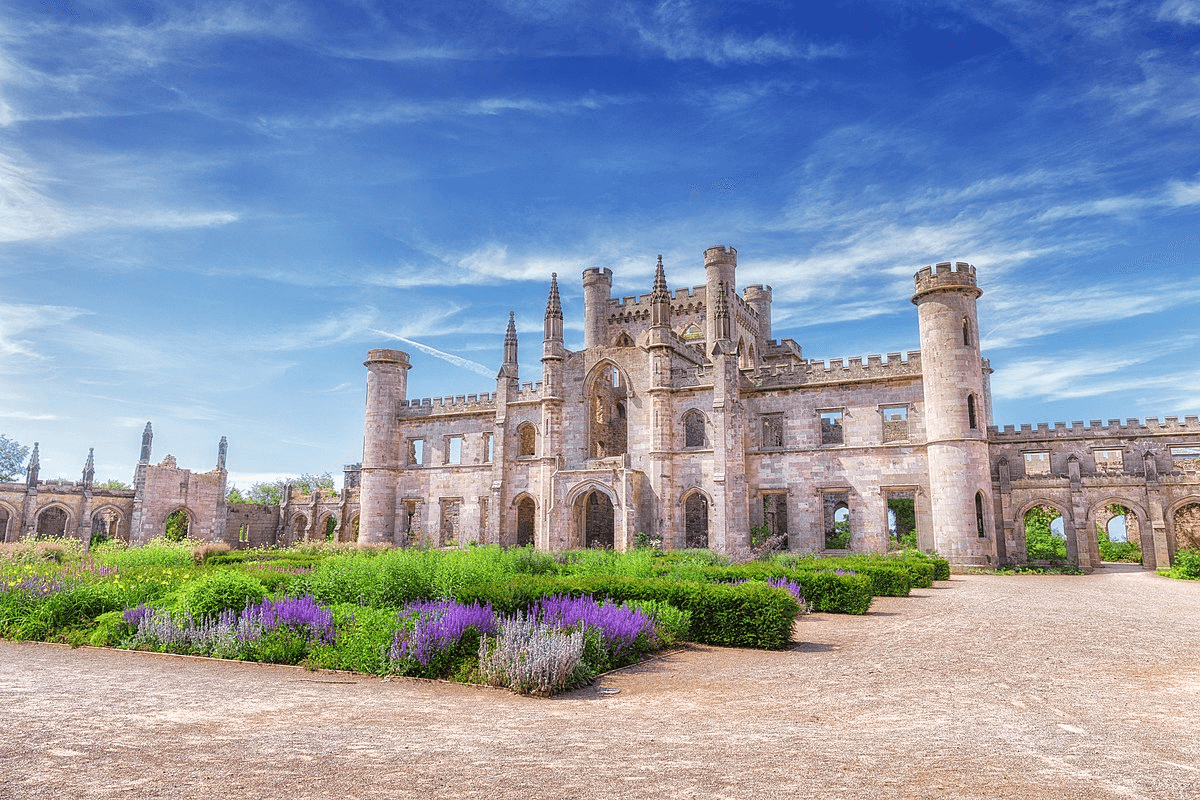
Brief History: Lowther Castle, nestled within the idyllic landscapes of the Lake District, stands as a testament to the grandeur of English country estates. Its origins trace back to the medieval period, but the castle as seen today was constructed in the early 19th century for the Lowther family, a lineage steeped in history and influence. Designed by architect Robert Smirke, the castle reflects the romantic Gothic revival style, embodying the era’s fascination with medieval architecture and the picturesque.
Architectural Highlights: The castle’s design is characterized by its imposing façade, dramatic battlements, and expansive windows that offer stunning views of the surrounding gardens and countryside. Though now a ruin, Lowther Castle’s architecture still captivates visitors, with its grand entrance hall and the skeletal remains of its once-lavish rooms. The gardens, partially restored, showcase the innovative landscaping techniques of the time, blending natural beauty with architectural design.
Visitor Information: Today, Lowther Castle is open to the public, offering a glimpse into its majestic past and the ongoing restoration efforts that aim to preserve its beauty for future generations. Visitors can explore the extensive grounds, which include the ruins of the castle, the gardens, and the adventure playground, making it a perfect destination for history enthusiasts and families alike.
- Opening Hours: Vary seasonally, typically from 10:00 AM to 5:00 PM.
- Admission Fees: There are fees for entry, with discounts available for children, families, and groups.
- Facilities: The site includes a café serving local produce, a gift shop, and ample parking.
- Special Events: Lowther Castle hosts a variety of events throughout the year, including outdoor theatre performances, historical reenactments, and seasonal festivals.
Photo Author Burtonsi
Muncaster Castle
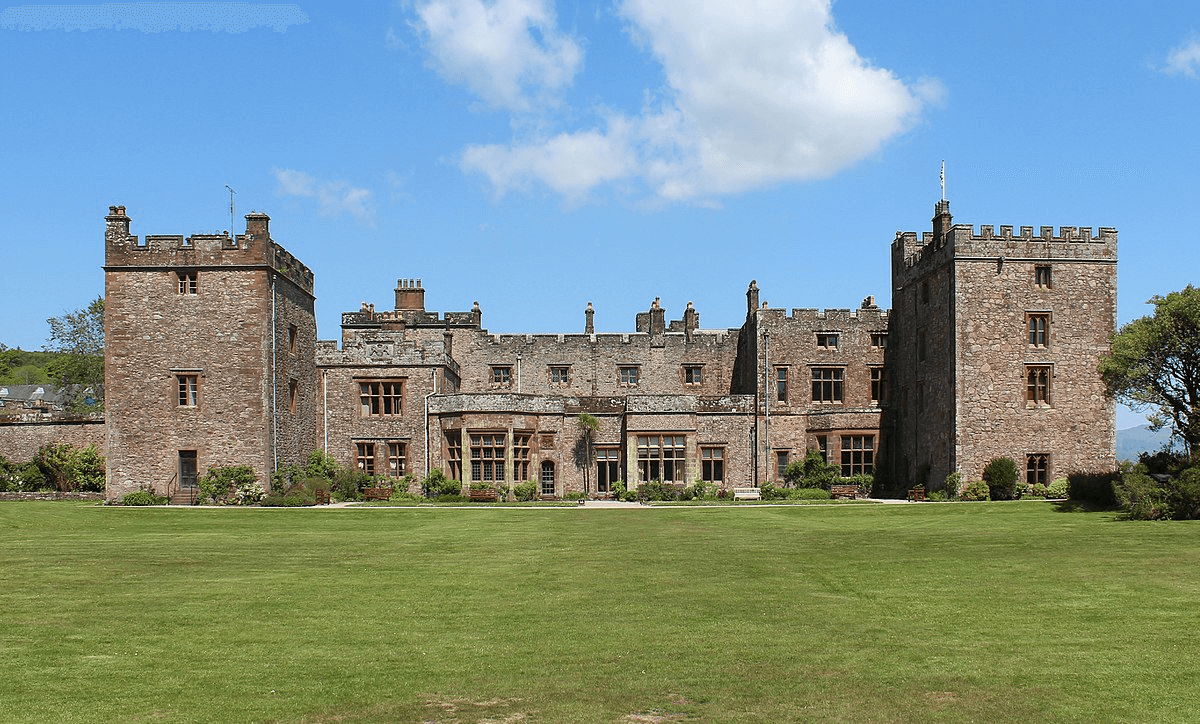
Brief History: Muncaster Castle, overlooking the Esk River, has been the family seat of the Pennington family for over 800 years. The castle’s core is a medieval fortress, with extensive modifications and expansions carried out in the Tudor and Victorian eras. Its history is rich with tales of intrigue, hospitality, and the legendary “Luck of Muncaster,” a glass bowl said to guarantee the family’s fortune as long as it remains intact.
Architectural Highlights: The castle boasts a mix of architectural styles, reflecting its long history and the various phases of construction and renovation it has undergone. Notable features include the Pele Tower, the Tudor Great Hall, and the Victorian Library. The gardens and grounds are renowned for their beauty, featuring rare plants, terraced lawns, and the wild, wooded areas known as the “Himalayan Gardens.”
Visitor Information: Muncaster Castle offers a unique blend of historical exploration, natural beauty, and family fun. The castle itself hosts guided tours, revealing its history and hauntings, while the gardens provide a peaceful retreat into nature.
- Opening Hours: Open daily from March to October, with limited opening times in the winter months.
- Admission Fees: Entry fees apply, with options for castle-only or gardens-only tickets, as well as combined tickets.
- Facilities: The site includes a café, a gift shop, ample parking, and several holiday cottages for overnight stays.
- Special Events: The castle is famous for its Hawk & Owl Centre, with daily flying displays, and hosts events like the Muncaster Festival and Halloween Week.
Photo Author Martinvl
Wray Castle
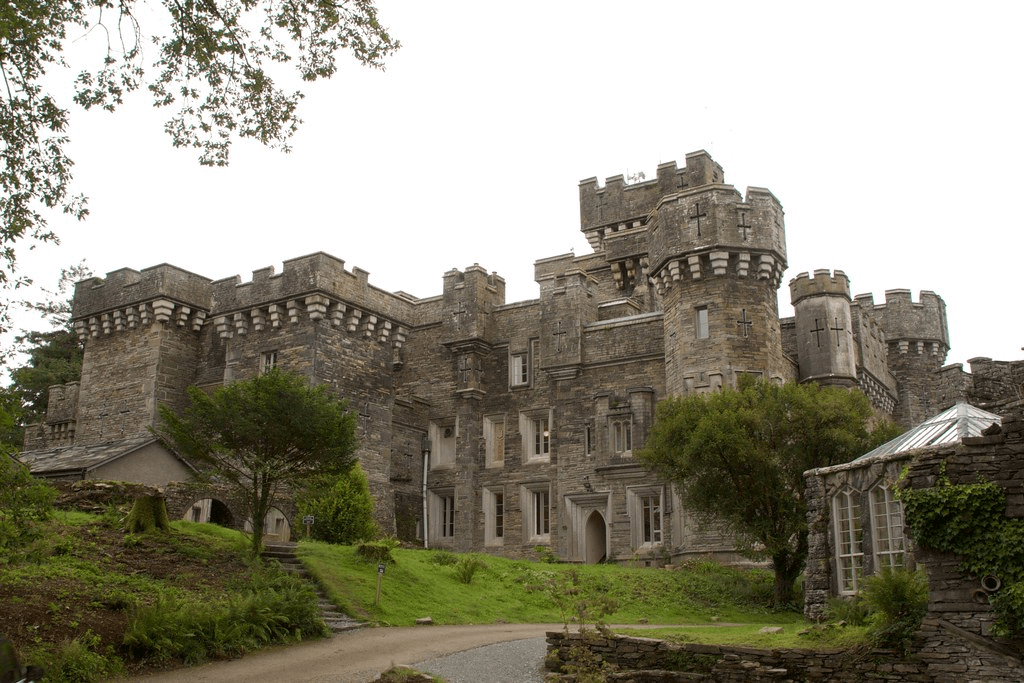
Brief History: Wray Castle, unlike many of its counterparts, was built in the 19th century, primarily as a private residence rather than a defensive fortress. This mock-Gothic castle was constructed in 1840 for James Dawson, a retired Liverpool surgeon, who desired a rural retreat in the picturesque Lake District. Though it never served a military purpose, Wray Castle embodies the Victorian era’s romanticized vision of medieval architecture, complete with turrets, towers, and castellated parapets.
Architectural Highlights: The castle’s design is a testament to the Victorian fascination with the medieval past, featuring an array of architectural elements inspired by Gothic and earlier medieval styles. Its interiors, however, were designed for comfort and modern living, reflecting the tastes and advancements of the 19th century. Notably, the castle was one of the first buildings in the area to have electricity, a modern marvel at the time.
Visitor Information: Now managed by the National Trust, Wray Castle is open to the public, offering a unique insight into Victorian interpretations of medieval architecture and 19th-century lifestyle.
- Opening Hours: Seasonal variations apply; typically open from late March to October.
- Admission Fees: Entry is free for National Trust members, with a fee for non-members. Check the National Trust website for the latest prices.
- Facilities: The castle offers a café, gift shop, and interactive exhibits, making it an ideal destination for families and history enthusiasts alike.
- Special Events: Wray Castle hosts a variety of events, including guided tours, family activities, and educational workshops, providing a deeper understanding of its history and architecture.
Carlisle Castle
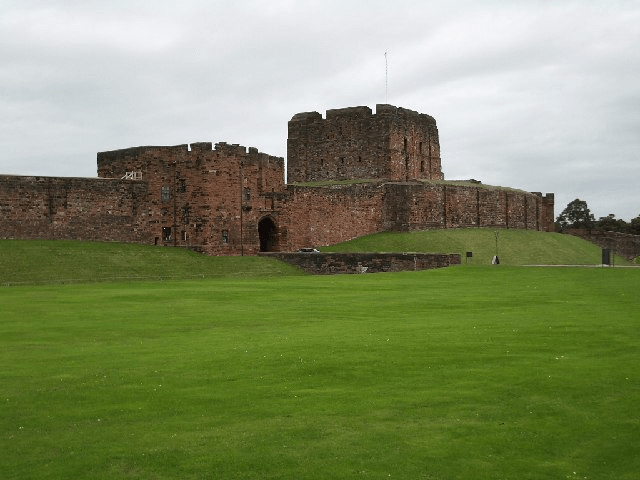
Brief History: Carlisle Castle stands as a formidable reminder of the turbulent history between England and Scotland. Founded in the 11th century by William Rufus, King William II of England, the castle has been a key military stronghold throughout its history, witnessing numerous sieges and battles, notably during the Wars of Scottish Independence.
Architectural Highlights: Carlisle Castle is renowned for its well-preserved medieval defensive structures, including the mighty keep, the imposing stone walls, and the half-moon battery, a testament to the castle’s strategic military importance. The castle also houses the medieval King’s Own Royal Border Regiment museum, offering a glimpse into the region’s martial history.
Visitor Information: Operated by English Heritage, Carlisle Castle welcomes visitors to explore its historic ramparts, medieval chambers, and military museum.
- Opening Hours: Open daily, with varying hours across seasons. It is advisable to check the English Heritage website for current opening times.
- Admission Fees: There are entry fees for adults, children, families, and concessions, with free entry for English Heritage members.
- Facilities: The castle features a shop and visitor facilities; guided tours are available, providing insights into the castle’s history and significance.
- Special Events: Carlisle Castle hosts a range of events throughout the year, including historical reenactments, family activity days, and seasonal celebrations, enriching the visitor experience.
Photo Attribution: John Gibson / Carlisle Castle / CC BY-SA 2.0
Sizergh Castle
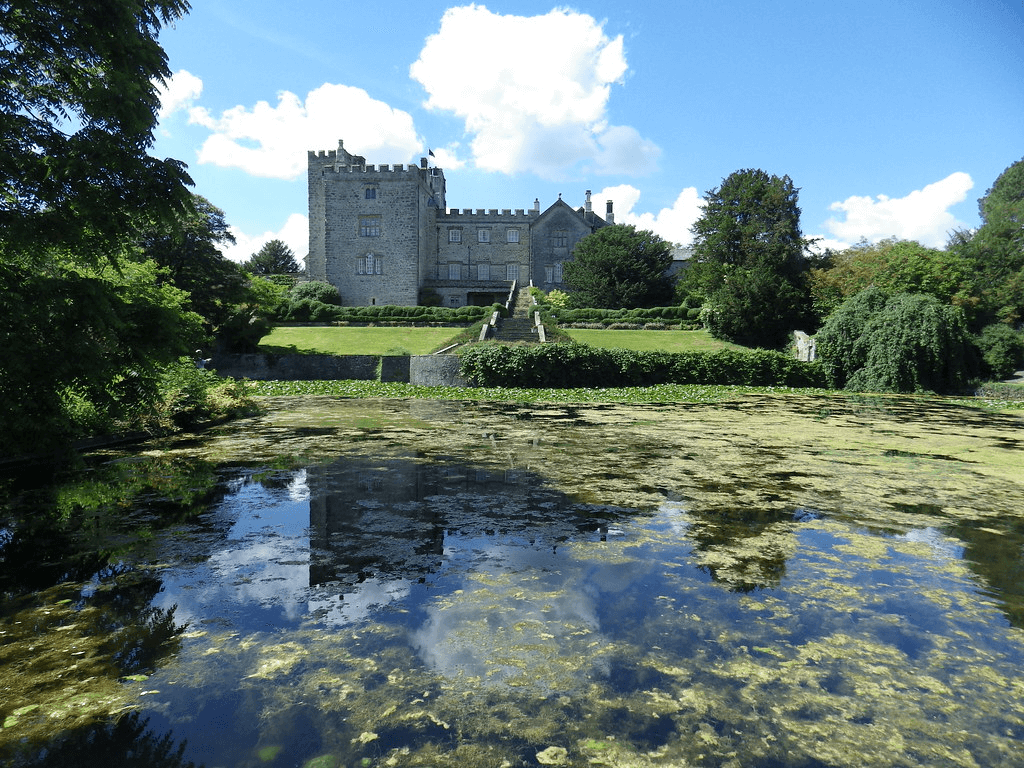
Brief History: Sizergh Castle, with its origins dating back to the Middle Ages, is a distinguished family home with over 700 years of history. This historic house was built by the Strickland family, who have lived in the area since 1239 and continue to reside there. Over the centuries, Sizergh has been expanded and embellished, incorporating elements from various architectural periods, making it a fascinating chronicle of England’s domestic architecture.
Architectural Highlights: The castle is renowned for its beautiful Elizabethan carvings and paneling, as well as its impressive collection of English and French furniture. One of its most celebrated features is the magnificent Inlaid Chamber, an Elizabethan room adorned with intricate wood marquetry. The surrounding gardens and estate offer a splendid array of landscapes, from formal gardens to wildflower meadows and ancient woodlands, showcasing the natural beauty of the Lake District.
Visitor Information: Sizergh Castle and Garden is managed by the National Trust, providing visitors with the opportunity to explore this historic estate’s rich heritage and natural beauty.
- Opening Hours: Open to the public from March to October, with limited opening during the winter months. It’s recommended to check the National Trust website for the most current information.
- Admission Fees: Entry fees apply for both the house and gardens, with discounts for children and families. National Trust members have free access.
- Facilities: The site features a café offering local Cumbrian produce, a shop with a range of gifts and souvenirs, and ample parking. The estate’s extensive grounds are also accessible for walks and exploration.
- Special Events: Sizergh Castle hosts various events throughout the year, including garden tours, historical exhibitions, and family-friendly activities, enhancing the visitor experience with insights into the property’s history and natural environment.
Brougham Castle
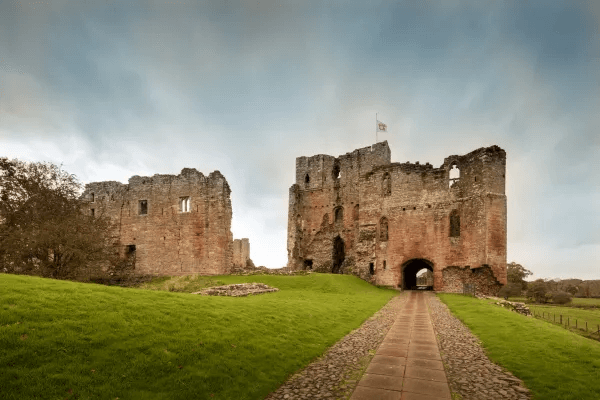
Brief History: Brougham Castle, located near the confluence of the rivers Eamont and Lowther, is a medieval building with a rich history that dates back to the early 13th century. Founded by Robert de Vieuxpont in the reign of King John, the castle has a storied past of border conflicts, changing ownership, and periods of renovation and decline. It played a significant role in the defense of the realm during the Anglo-Scottish wars and has connections to famous historical figures, including Lady Anne Clifford, who restored it in the 17th century.
Architectural Highlights: The ruins of Brougham Castle are evocative and picturesque, with key features including the impressive keep, the gatehouse, and the remains of the great hall. Despite its ruined state, the castle offers a palpable sense of medieval life and the strategic importance of its location. The site provides a unique window into the architecture and daily existence of those who lived and worked within its walls.
Visitor Information: Managed by English Heritage, Brougham Castle is open to the public, offering a chance to explore one of Cumbria’s significant historical sites.
- Opening Hours: Seasonal variations in opening hours; visitors are encouraged to check the English Heritage website for up-to-date information.
- Admission Fees: A modest entry fee is charged, with concessions for children, families, and groups. English Heritage members can visit for free.
- Facilities: While the castle itself offers limited facilities, informational panels provide insights into its history and significance. Nearby Penrith offers a range of amenities for visitors.
- Special Events: The castle’s dramatic backdrop makes it a popular location for educational visits, historical reenactments, and photography, offering a deep dive into England’s medieval past.
Penrith Castle
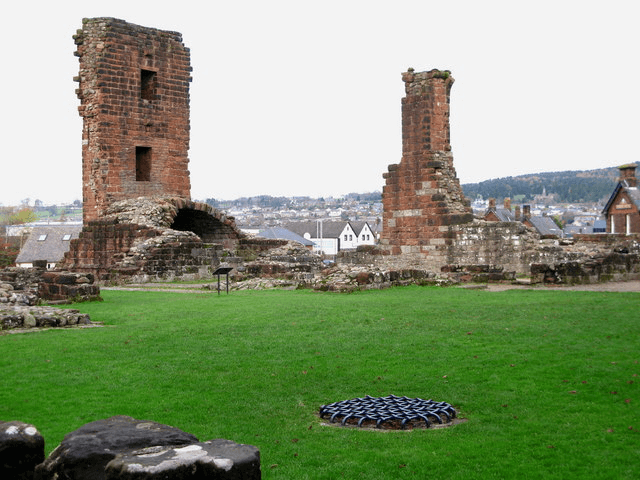
Brief History: Penrith Castle, now a captivating ruin set against the backdrop of the Eden Valley, began its life in the late 14th century as a pele tower. It was built by Ralph Neville, who later became the 1st Earl of Westmorland, as a defense against Scottish raids. The castle saw significant expansion and fortification in the 15th century, especially under the auspices of Richard, Duke of Gloucester, who later became King Richard III of England. Its military relevance waned after the Tudor period, leading to its decline into ruin.
Architectural Highlights: Despite its ruined state, Penrith Castle offers a glimpse into medieval military architecture. The red sandstone walls, gatehouse, and fragments of the towers and living quarters evoke images of its past splendor. The castle’s layout, with its inner and outer wards, provides insights into the defensive strategies employed during its operational years.
Visitor Information: Penrith Castle is managed by English Heritage and is freely accessible to the public, making it an excellent stop for history buffs and casual visitors alike.
- Opening Hours: The castle grounds are open daily, providing a year-round opportunity for visits, with no admission fee.
- Facilities: Direct facilities at the castle are minimal, but its central location in Penrith means that cafes, shops, and other amenities are just a short walk away.
- Special Events: While the castle itself does not host many events, its presence enhances the cultural landscape of Penrith, with the town offering various festivals and activities throughout the year.
Photo Attribution: David Rogers / Penrith Castle / CC BY-SA 2.0
Appleby Castle
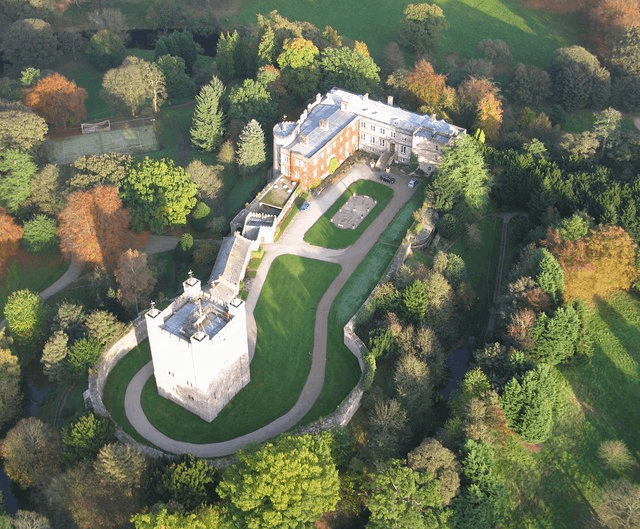
Brief History: Appleby Castle, a historic fortification set in the heart of Cumbria, boasts over 900 years of history. The castle has been a key northern stronghold since the Norman Conquest, with the original castle built in the form of a motte and bailey by Ranulf le Meschin in the early 12th century. Throughout the centuries, it has been the seat of the Kings of Scots and the Clifford family, with Lady Anne Clifford being a notable resident who restored the castle and many others in the 17th century.
Architectural Highlights: Appleby Castle is unique in that it has been continuously inhabited since its construction. The castle features a Norman keep, known as Caesar’s Tower, which is among the oldest surviving structures of its kind in England. The mansion house, added in the 17th century, showcases a blend of medieval and Tudor architecture, offering a rich insight into the castle’s development over time.
Visitor Information: Today, Appleby Castle is open to the public, offering guided tours that delve into its rich tapestry of history.
- Opening Hours: The castle operates guided tours on specific days, and it is recommended to book in advance to secure a spot.
- Admission Fees: Admission is charged for the guided tours, with different rates for adults, children, and families.
- Facilities: The castle offers accommodation, a restaurant serving local produce, and hosts events like medieval banquets, making it a unique historical experience.
- Special Events: Appleby Castle hosts a variety of events, including historical reenactments, themed dinners, and educational workshops, providing a dynamic exploration of its heritage.
Photo Author Simon Ledingham
Kendal Castle
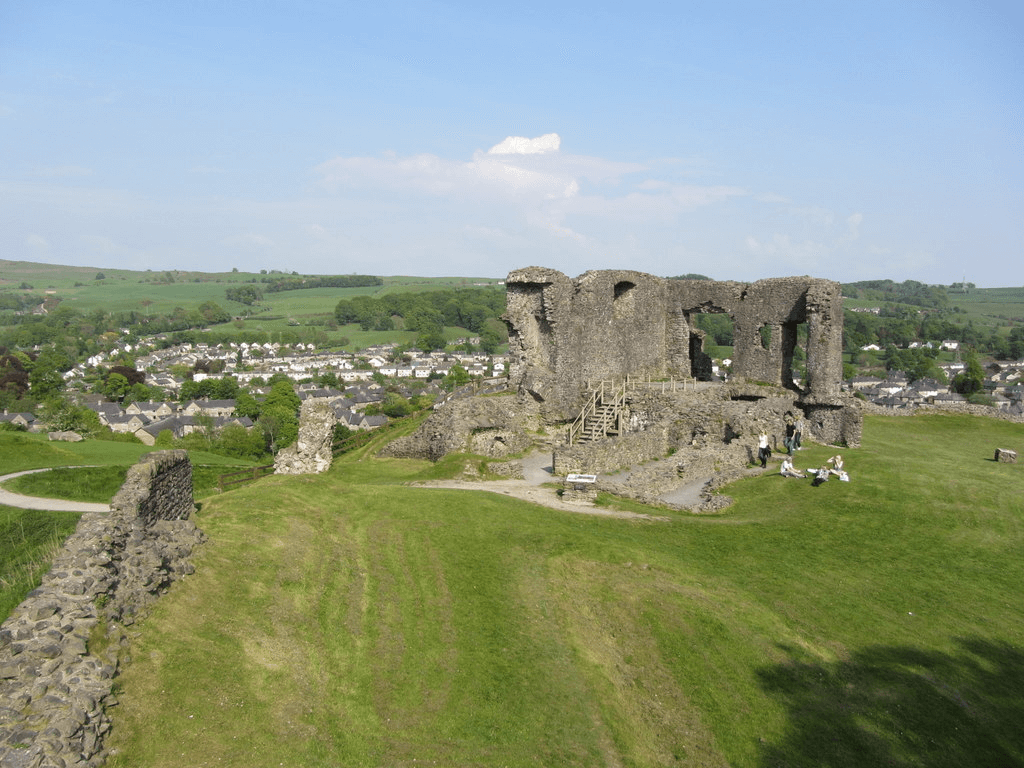
Brief History: Kendal Castle, now in ruins, was once a medieval stronghold and the ancestral home of the Parr family, most notably Catherine Parr, the sixth wife of King Henry VIII. Believed to have been built in the late 12th century, the castle served as an important administrative center for the Barony of Kendal. Over the centuries, it fell into disrepair, with much of its stone repurposed for local buildings, leaving the evocative ruins that can be seen today.
Architectural Highlights: The castle’s ruins provide a window into medieval life, with the remnants of the great hall, towers, and walls standing on a hill offering panoramic views over Kendal and the surrounding countryside. Although much of the structure is gone, the layout is still discernible, allowing visitors to imagine its past grandeur.
Visitor Information: Kendal Castle is freely accessible to the public, making it a popular spot for both locals and tourists to explore and enjoy the scenic views.
- Opening Hours: The castle grounds are open year-round, with unrestricted access during daylight hours.
- Facilities: There are no on-site facilities, but the castle’s proximity to Kendal town center means that amenities are readily available nearby.
- Special Events: While the castle itself does not host events, its presence enhances the cultural and historical appeal of Kendal, with the town offering various festivals and activities throughout the year.
Photo Author Colin Park
Brough Castle
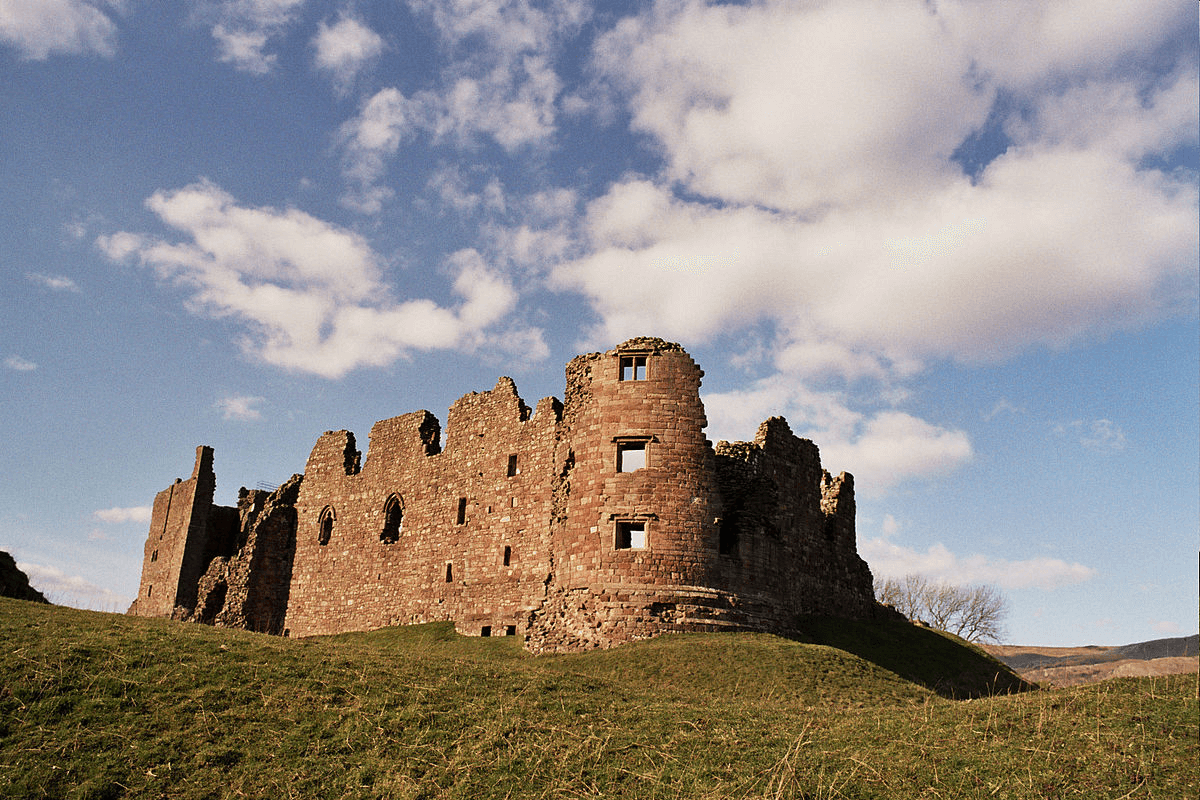
Brief History: Brough Castle, located on the site of a Roman fort at the eastern end of the Eden Valley, has a complex history that spans over a millennium. Initially constructed in the 11th century within the earthworks of the Roman fort, it was rebuilt in stone in the 12th century by the Normans. The castle has witnessed several rebuilds and repairs following damage from Scottish raids and a catastrophic fire in the 16th century. It was partially restored in the 17th century by Lady Anne Clifford.
Architectural Highlights: The ruins of Brough Castle include the remains of the keep, a significant portion of the curtain wall, and the gatehouse. The castle’s position offers strategic views over the surrounding landscape, illustrating its importance as a defensive site. The Clifford Tower, part of the 17th-century renovations, remains a focal point for visitors, showcasing the blend of medieval and post-medieval architecture.
Visitor Information: Brough Castle is managed by English Heritage and is open to the public, offering a fascinating glimpse into the region’s rich history.
- Opening Hours: The castle grounds are accessible to visitors throughout the year, with seasonal variations in opening times for specific areas. It’s advisable to check the English Heritage website for the most current information.
- Admission Fees: Entrance to Brough Castle is free, making it an accessible option for those looking to explore the historical heritage of the Lake District.
- Facilities: On-site facilities include a tearoom (operating seasonally) located in the old manor house, providing refreshments in a historic setting. Informational panels throughout the site offer insights into the castle’s history and significance.
- Special Events: While specific events at Brough Castle are rare, its open-access policy allows for a leisurely exploration of its ruins and the picturesque surroundings at any time.
Conservation and Tourism
The castles of the Lake District, with their storied pasts and architectural grandeur, are not just relics of history; they are vibrant parts of Cumbria’s cultural landscape, attracting visitors from around the globe. However, the preservation of these historic structures in the face of time, weather, and increasing tourist numbers presents a significant challenge. The balance between conservation and tourism is delicate, requiring careful management to ensure that these monuments can be enjoyed by future generations.
The Challenge of Conservation
Conserving historic castles involves a multitude of challenges, from structural repairs to the maintenance of their surrounding landscapes. Many of these structures are centuries old, built in an era with vastly different construction techniques and materials. Exposure to the elements over time has led to deterioration in some cases, necessitating ongoing restoration efforts to stave off further decay. Additionally, as these sites become more popular tourist destinations, the wear and tear from visitors also increases, compounding the conservation challenges.
The Role of Government Bodies and Local Communities
Government bodies, such as English Heritage and the National Trust, alongside local communities, play crucial roles in the conservation of Cumbria’s castles. These organizations are responsible for securing funding for restoration projects, conducting research to guide conservation efforts, and implementing visitor management strategies that minimize environmental impact. Local communities are also instrumental, contributing through volunteer work, advocacy, and educational programs that raise awareness about the importance of preserving their heritage.
Balancing Conservation with Tourism
Tourism, while a potential threat to the preservation of historic sites, also offers a solution. The revenue generated from visitor admissions, merchandise, and events is vital for funding conservation projects. Therefore, managing tourist access in a way that protects the integrity of the castles while providing a fulfilling visitor experience is key. This includes implementing measures such as controlled entry, guided tours that limit access to sensitive areas, and the creation of visitor centers that provide comprehensive information without impacting the site directly.
Successful conservation efforts often involve innovative approaches to both protect the structure and engage the public. For example, restoration works are sometimes conducted in view of the public, serving as a live educational tool about the challenges and techniques involved in preserving historic buildings. Additionally, engaging storytelling and interactive exhibits can enhance visitor experience, making history accessible and entertaining while diverting traffic from the most vulnerable parts of a site.
The Future of Castle Conservation and Tourism
The future of Cumbria’s castles as both historical monuments and tourist attractions depends on the continued collaboration between conservationists, government agencies, local communities, and visitors. Education plays a pivotal role in this, as informed visitors are more likely to appreciate and respect the heritage sites they explore. Moreover, the adoption of sustainable tourism practices, such as reducing carbon footprints and supporting local economies, contributes to the broader goal of preserving these castles for posterity.
As we look forward, the conservation of Cumbria’s castles remains an ongoing journey, one that balances the preservation of their historical essence with the needs and interests of modern-day visitors. Through concerted efforts and sustainable practices, these majestic structures can continue to captivate and educate, standing as proud emblems of the region’s rich heritage.
Visiting the Castles: Tips and Recommendations
Exploring the historic castles of the Lake District offers a unique glimpse into England’s medieval past, but to ensure that your visit is both enjoyable and sustainable, it’s important to consider a few tips and recommendations. These suggestions aim to enhance your experience while supporting the ongoing efforts to preserve these magnificent sites for future generations.
Best Times to Visit
- Avoid Peak Times: To escape the crowds and enjoy a more serene visit, consider touring the castles during off-peak times, such as weekdays or outside of school holidays.
- Seasonal Beauty: Each season offers a different perspective on the castles and their surroundings. Spring and autumn provide beautiful natural backdrops, while summer offers longer days for exploration. Winter visits can be magical, with fewer tourists and frosty landscapes, though some castles may have limited access or hours.
Making the Most of Your Visit
- Guided Tours: Whenever available, opt for a guided tour. These tours often provide insights and stories that you won’t find in guidebooks, enriching your understanding of the castle’s history and significance.
- Family-Friendly Activities: Many castles offer activities tailored to families and children, such as interactive exhibits, treasure hunts, and workshops. These can make the visit educational and entertaining for all ages.
- Accessibility: Check in advance for accessibility options. Many historic sites have made efforts to accommodate visitors with mobility issues, but due to the nature of ancient buildings, some areas might be less accessible.
Supporting Conservation Efforts
- Respect the Site: Follow guidelines and respect barriers to help preserve the site. Avoid touching or climbing on ancient structures, as this can cause damage over time.
- Support Local: Purchasing tickets, merchandise, or refreshments at the castle supports conservation efforts directly. Additionally, patronizing local businesses in the surrounding communities can contribute to the region’s economy.
Nearby Attractions
- Explore the Area: Complement your castle visit with explorations of nearby attractions. The Lake District is renowned for its natural beauty, offering a plethora of walks, lakes, and picturesque villages to discover.
By following these tips, visitors can ensure their castle explorations are not only memorable but also contribute positively to the preservation and appreciation of these historic treasures.

